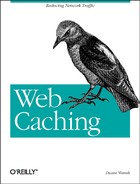I’ve used many acronyms throughout this book, in some cases without explanation. This glossary provides brief descriptions for acronyms only. Although the definitions aren’t very detailed, they should be enough to get you started in the right direction on your search for more information.
A
- ACK
An acknowledgment packet in TCP, used to guarantee delivery and for connection establishment.
- AFS
The Andrew Filesystem. A distributed/network filesystem similar to NFS.
- ARP
Address Resolution Protocol. Used to find out the layer two (Ethernet) address associated with an IP address.
- ASP
Active Server Pages. A technique for dynamically generating HTML pages, developed by Microsoft and similar to CGI.
- ATM
Asynchronous Transfer Mode. A layer two data transmission protocol, typically used on high-speed fiber links.
B
- BIND
Berkeley Internet Name Daemon. The de facto standard DNS server and client library software package. For more information, visit http://www.isc.org/products/BIND/.
C
- CARP
Cache Array Routing Protocol. A technique for distributing requests to an array of caching proxies.
- CDA
Communications Decency Act. A U.S. law passed in 1996 intended to criminalize the transmission of pornography. Largely struck down as unconstitutional in 1997.
- CDF
Cumulative Distribution Function. A certain way of presenting probability distribution data.
- CDN
Content Distribution Network. A service, available from companies such as Akamai and Digital Island, that replicates origin server content at different Internet locations.
- CGI
Common Gateway Interface. An interface between a web server and external programs, mostly used for generating dynamic HTTP responses. For more information, visit http://hoohoo.ncsa.uiuc.edu/cgi/overview.html.
D
- DHCP
Dynamic Host Configuration Protocol. A broadcast protocol that enables hosts to discover their network configuration, such as IP addresses and host names. One of the discovery methods supported by WPAD.
- DMCA
Digital Millennium Copyright Act. A law passed in 1998 that brings the U.S. into compliance with international treaties and also addresses issues raised by the so-called “Information Age.”
- DMZ
Demilitarized Zone. A term borrowed from military battlefields to describe a small network that separates internal networks from the hostile Internet.
- DNS
Domain Name System. A distributed database that contains different types of records for Internet domain names. Most often used to translate host names into IP addresses. Documented in RFCs 1034, 1035, and others.
F
- FDDI
Fiber Distributed Data Interface. A local area network data transmission standard that uses optical fibers and runs at 100 Mbps.
- FTP
File Transfer Protocol. The Internet’s original bulk data transfer protocol. Documented in RFC 959.
G
- UPS
Uninterruptible Power Supply. Provides backup power in the event of an outage.
- URI
Uniform Resource Identifier. A standard naming scheme for web resources. Documented in RFC 2396.
- URL
Uniform Resource Locator. A subset of URIs, URL resources are tied to specific locations (hostnames).
- URN
Uniform Resource Name. A subset of URIs, URN resources are not tied to specific locations.
- UTC
Universal Time Coordinated. Equivalent to GMT.
W
- WAIS
Wide Area Information Service. A protocol for searching databases and retrieving results. Popular around 1994–1995 but not used much today.
- WCCP
Web Cache Coordination Protocol. Cisco’s formerly proprietary protocol for communication between network devices (routers, switches) and caching proxies.
- WEBDAV
Distributed Authoring and Versioning extensions to HTTP. Used for certain applications such as remote file editing and email.
- WEBI
Web Intermediaries. A working group of the IETF chartered to address issues related to caching proxies and other types of web intermediaries.
- WPAD
Web Proxy Auto-Discovery. A protocol that user-agents can use to discover caching proxies.
- WREC
Web Replication and Caching. A now defunct working group of the IETF. For more information, visit http://www.wrec.org.
X
- XML-RPC
A protocol specification for making remote procedure calls using HTTP as the transport and XML as the encoding. For more information, visit http://www.xmlrpc.co.
